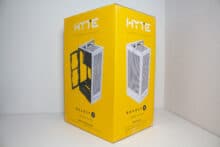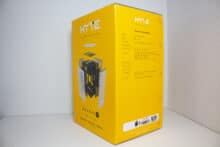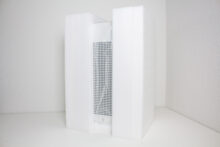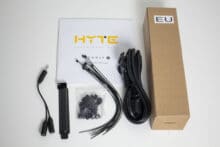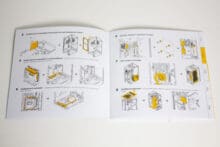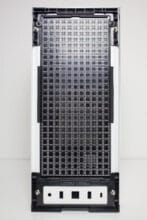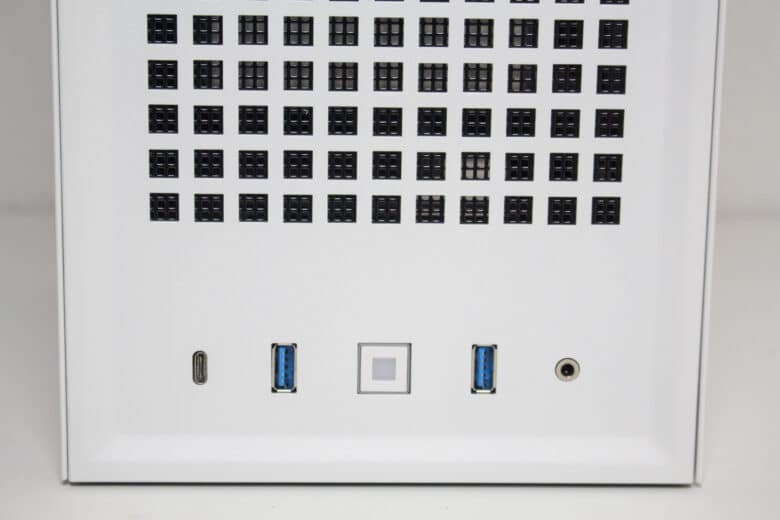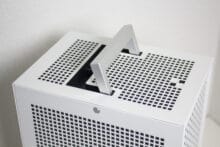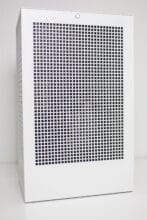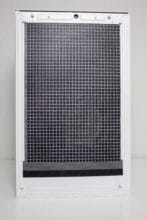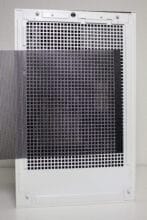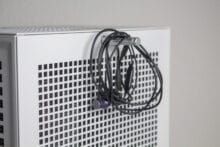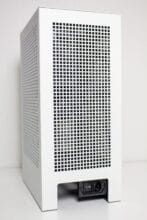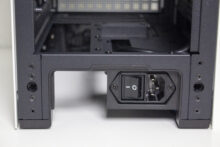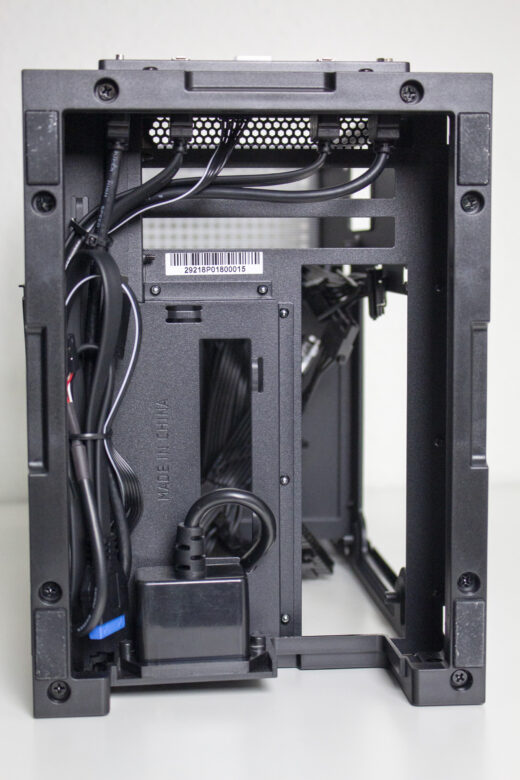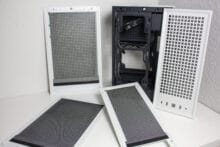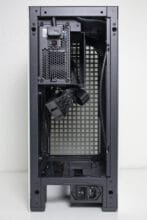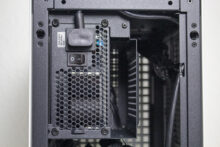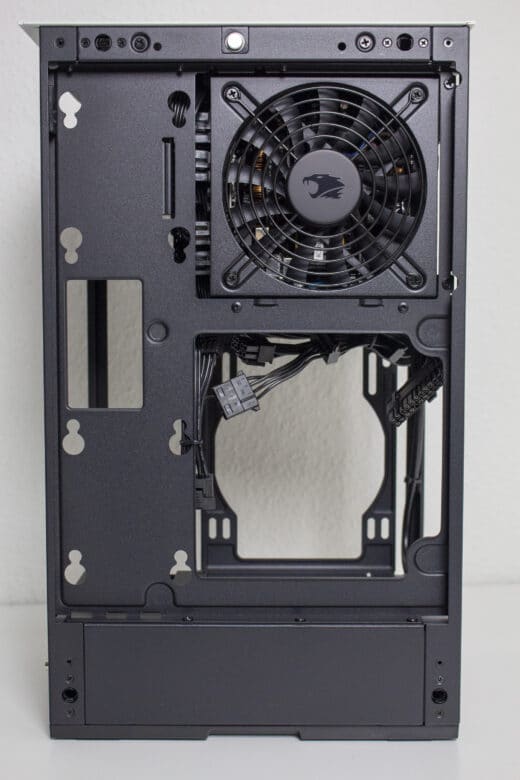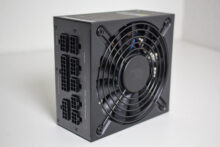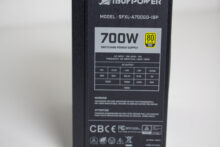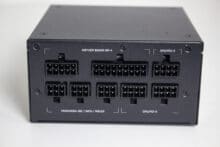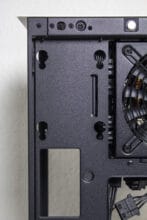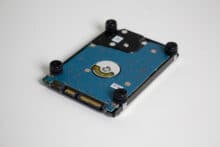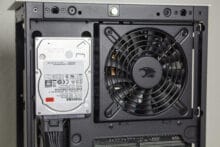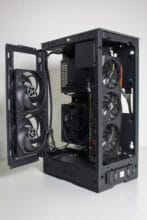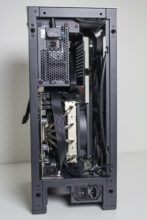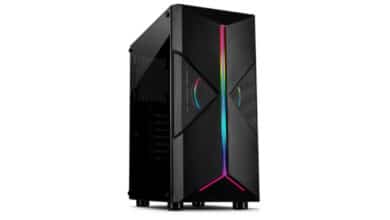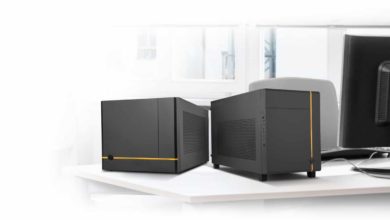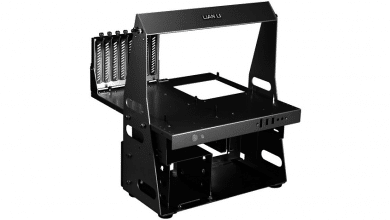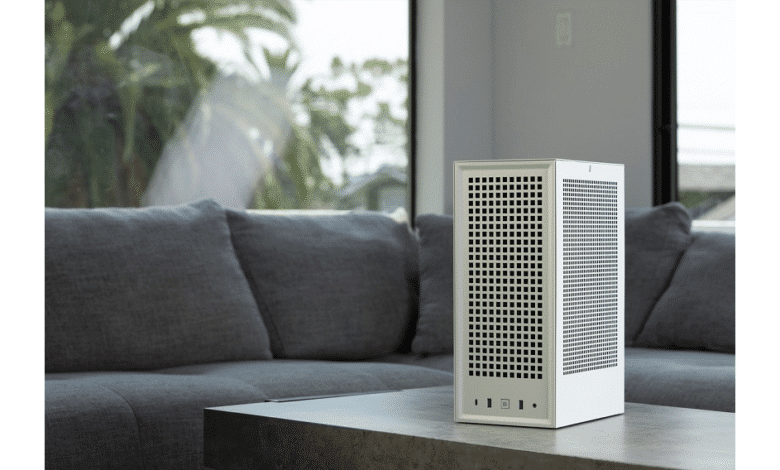
The HYTE brand is a subsidiary of the system integrator iBUYPOWER, which normally offers an extensive portfolio of high-quality, pre-configured PC systems. Via the HYTE brand, the company is now also entering the highly competitive market for PC components and accessories and presented an interesting case with the Revolt 3 for a start.
The HYTE Revolt 3 is an SFF case that has room for ITX mainboards and long graphics cards. Its tower shape makes it somewhat reminiscent of the NZXT H1, but this allows for a vertical orientation of the graphics card, leaving a smaller footprint on the desk. Features include compatibility with 280 AiO water cooling and long 2.7-slot graphics cards. Price-wise, HYTE is pricing the version without a PSU at €129 and with a pre-installed 700W PSU at €249. Find out if it’s worth it in this review.
Technical details
| Model: | HYTE Revolt 3 |
| Case Type: | ITX |
| Dimensions: | 178 mm (W) x 409 mm (H) x 253 mm (D) |
| Weight: | 6.3 kg (with power supply) |
| Material: | Aluminum, steel, plastic |
| Color: | White |
| Front connectors | 1x USB 3.2 Type-C, 2x USB 3.0 Type-A, 1x HD Audio |
| Drive bays: | 1x 3.5″ (internal) 2x 2.5″ (internal) |
| Expansion slots: | 3x horizontal |
| Form factors: | ITX |
| Ventilation: | Back: 1x 120 mm Lid: 2x 140/ 120 mm Bottom: 2x 140/ 120 mm |
| Radiators: | Side: 1x 280/ 240 mm (max. 35 mm deep) |
| Max. CPU cooler height: | 140 mm |
| Max. Graphics card dimensions: | up to 335 (L) x 140 (H) x 58mm (D) |
| Max. Net part length: | SFX, SFX-L |
| Price: | € 155.19 * (without power supply), € 465.30 * (with power supply) |
| Features: | magnetic dust filter, carrying handle, integrated 700W power supply (80 Plus Gold) |
Scope of delivery
HYTE packages the Revolt 3 in a very eye-catching cardboard box. The packaging is dominated by the colors yellow and blue. In addition to numerous product illustrations, there is also a table on one side with all the important features and the information about the color as well as the power supply. Inside, the Revolt 3 is encased in a soft foam and plastic film. Furthermore, when opening the box, you are immediately greeted by a very detailed assembly manual, which HYTE has written in several languages. The mounting accessories are in a cardboard box, which has been fastened inside the case with a cable tie. This contains all the necessary mounting screws and rubber rings, some cable ties, an IEC cable for the power supply, two PCI slot bezels as well as a Y-crossover for the HD audio compoport in the front. Furthermore, five pre-installed dust filters and, in our version, the pre-installed SFX-L power supply with 700W belong to the scope of delivery.
Exterior impression
Externally, HYTE focuses on a simple look and does not use design elements such as tempered glass or RGB. Instead, the focus is on optimal airflow, which is to be achieved through large, square vents on all external case elements.
At the front, these vents are slightly recessed, giving the Revolt 3 a slightly more dynamic look. The front panel is attached via four steel pins, which have to be pressed into corresponding receptacles on the body. This makes the (dis)assembly of the panel very easy. Behind the grille there is another mesh grille, which is probably supposed to serve as a dust filter and is screwed to the front element.
In the lower area of the Revolt 3, the I/O panel has been attached and equipped as follows: 2x USB 3.0 Type-A (internal port), 1x USB 3.2 Type-C port (external port), 1x HD audio combo port, 1x power button (illuminated in white). We find it a bit of a shame that the USB Type-C port can only be externally linked to the motherboard.
The lid also features the square vents and a very special feature. The manufacturer has equipped the Revolt 3 with a carrying handle that can withstand a weight of up to 14 kilograms. The handle is recessed into the lid and has a spring-loaded attachment mechanism. If you exert slight pressure, the handle pops up. Unfortunately, the handle seems a bit wobbly and rattles a bit when unfolded. Unlike the front, the lid plate is fixed with four screws. Removing this plate gives access to a mounting spot for an 80 millimeter fan and the magnetic dust filter.
Both side panels follow the design of the front, but have slightly smaller vents and are not recessed like the front panel. Here, too, the mounting to the body is done via four push pins, which significantly speed up the (dis)assembly of the side panels. HYTE also installs magnetic dust filters on the back of the side panels, which are easy to remove. A special feature is the retractable headset holder, which the manufacturer has installed on both sides.
The back shows a similar appearance as the sides. The steel panel installed here was also equipped with square vents and a magnetic dust filter on the back. The type of mounting is the same as the front panel. There is also a power cable connection including an on/off switch in the lower area. This means the case doesn’t have to be opened every time the PC needs to be unplugged.
On the bottom, the manufacturer has placed the cutout for the I/O shield and the graphics card’s display connectors. By means of a four centimeter deep chamber, HYTE creates space for the connectors so that they can be routed to the back. The I/O panel’s cables are also found in this chamber, which can be routed into the interior via an elongated opening. The Revolt 3 gets a secure stand via a solid steel frame, which was covered with thin rubber strips to minimize vibrations.
The exterior finish and paint are basically very good. Although no aluminum is used, the steel used for all panels is solid and the mounting mechanisms for the front, back and both sides appear stable and of high quality. Unfortunately, the carrying handle and the headset holders seem a bit clattery when folded out.
Interior impression
If you remove all the panels, what remains of the Revolt 3 and regardless of the exterior color is a black steel frame. If you also paid close attention to the exterior description, you might now be wondering how the motherboard is actually housed in this SFF case. If you look at the Revolt 3 from the left side, you first encounter a fan/radiator frame. After removing four screws, this can be easily flipped open to reveal a large main chamber.
The bottom of the main chamber is where the motherboard is mounted with the I/O panels facing down. Since HYTE has done without a riser cable, the graphics card must therefore be placed vertically inside the chamber. This results in the graphics card sitting directly behind the front panel and being able to draw in fresh air above it. The rear and front of the interior are freely accessible and are not blocked. In the upper area you can still find the power supply cage, in which the included power supply has already been installed. The inserted power cable has been pre-routed and terminates in the socket at the back of the Revolt 3.
The back of the motherboard tray reveals a narrow chamber that houses two mounting options for 2.5″ hard drives and the fan of the pre-installed power supply. Furthermore, the tray has been equipped with a cutout that allows for a CPU cooler backplate to be retrofitted. In addition, HYTE has also thought of a cable management opening and equipped both the front and back of the motherboard tray with some retaining eyelets for cable ties.
The pre-installed power supply is from iBUYPOWER, bears the model name SFXL-A7000GD-IBP and is based on the SFX-L format. According to the nameplate, the PSU reaches a maximum power of 700W on the single 12V rail with a maximum output current of 58.4 amps. The PSU has the following connectors: 1x 24-pin ATX, 1x 8-pin EPS12V, 2x 6+2-pin PCIe, 1x 6-pin PCIe, 4x SATA, 1x Molex. Furthermore, an 80 Plus Gold sticker can be found on the nameplate. However, this is not an official certification. This does not necessarily mean that the power supply does not reach the 80 Plus Gold efficiency level. Instead, it could be that HYTE simply wanted to save on licensing costs at this point.
For hard drives or SSDs, the Revolt 3 offers a total of three mounting options. The back of the mainboard tray offers space for two 2.5″ data carriers. The mounting is done via four rubber rings and four special screws with which the SSD is slid into the holding lugs. A single 3.5″ HDD can be accommodated above the power supply. The mounting is done via four simple screws and can be a bit tricky, depending on the cable management.
System installation in the HYTE Revolt 3
Now we come to the system build. For hardware, we’re using a AMD Ryzen 7 3700X on a € 149.00 * with 32GB Crucial Ballistix Sport. The Ryzen is cooled by a Noctua NH-L12 S1 Ghost and is not overclocked. A GTX 1060 6GB from Gigabyte AORUS is responsible for the image output. The power supply is handled by the Revolt 3’s integrated SFX-L power supply with 700W and 80 Plus Gold certification.
Installing and wiring hardware in an ITX case is not always simple or quick. The big advantage with the Revolt 3 with power supply is that HYTE has already laid and strapped most of the cables in advance so that you only have to connect them. Due to the foldable fan frame, the mainboard could be installed and screwed very easily. The cabling was a bit more difficult. The power supply cable for the CPU (8-pin EPS12V) is relatively short and was just enough for our motherboard. The cables of the I/O panel are also routed from below into the interior and run once across the mainboard. The installation of a graphics card was again very easy due to the generous space. If you wanted to install a particularly large card, you could also remove the cover element and move the card into the interior from above.
In terms of hardware compatibility, the Revolt 3 can hold its own. A maximum of 140 millimeters of space is available for air coolers if the side fans are omitted. Those who would rather install an AiO water cooler also have an option. The side bracket allows mounting a 240 or 280 mm radiator with a maximum depth of 35 millimeters (without fan). For graphics cards, the maximum dimensions depend heavily on the design of the card. Thus, HYTE gives the values 335 (L) x 140 (H) x 58mm (D) as a rough guideline. Additionally, there is also a table on the manufacturer’s website in which compatible and incompatible graphics cards are listed.
Finally, we come to the temperatures that were reached in the HYTE Revolt 3. During the stress test, Prime95 and FurMark were run for 15 minutes at a room temperature of 22°C. Furthermore, the test was performed with two different fan speeds and without a dust filter.
Scenario |
Temperature |
| CPU: 50% PWM (1125 rpm) GPU: 50% PWM (1650 rpm) without fan (default configuration) with dust filter |
CPU: 85 °C GPU: 79 °C |
| CPU: 50% (1125 rpm) GPU: 50% PWM (1650 rpm) 2x 120 mm on 50% (1125 rpm), blowing out on the side with dust filter |
CPU: 70 °C GPU: 64 °C |
| CPU: 50% (1125 rpm) GPU: 50% PWM (1650 rpm) 2x 120 mm on 50% (1125 rpm), blowing out on the side Without dust filter |
CPU: 67 °C GPU: 64 °C |
| CPU: 100% (1850 rpm) GPU: 50% PWM (1650 rpm) 2x 120 mm on 100% (1850 rpm), blowing out on the side Without dust filter |
CPU: 62 °C GPU: 61 °C |
That you don’t run an ITX system without a fan should actually be clear to everyone. Our measurements have also confirmed this once again. Without case fans, the CPU with 85 °C and the GPU with 79 °C do not yet reach critical, but still quite high temperatures. With two blowing fans on the side, we could reduce both values by 15 °C each. Removing the dust filters added another 3 °C on the CPU’s side. Overall, the Revolt 3 does quite well even with air-only cooling. However, HYTE has basically tuned the Revolt 3 more for the installation of an AiO water cooling than for air cooling.
Summary of the HYTE Revolt 3
HYTE makes a good debut into the case market with the Revolt 3. The Revolt 3 is a visually appealing case with mostly very good build quality and, for an ITX case, excellent hardware compatibility. In addition, installation of all components was very easy and HYTE completely eliminates the need for a riser cable in the layout. Lastly, there is the cooling potential. With two case fans and a regular air cooler, our 3700X was kept well under control. The layout of the Revolt 3 is nevertheless clearly designed for the installation of an AiO water cooler.
A nice gimmick is also the grab handle and the headset holders on the side. Unfortunately, their implementation is somewhat lacking in quality. Especially when unfolded, all three elements look a bit clattery. Instead, another lid that supports a 120 millimeter fan, for example, might have made more sense. Furthermore, the I/O panel cables are partly quite tight and run once across the motherboard.
Finally, there is the price. With €129 without power supply and €249 with power supply, the Revolt 3 is placed exactly between the SSUPD Meshlicious and the NZXT H1. However, the two variants allow you to decide for yourself whether or not you need a power supply with the Revolt 3. If you are looking for an ITX case in tower format, then the HYTE Revolt 3, despite certain flaws, is a very good option from our point of view and therefore gets a recommendation from us.
HYTE Revolt 3
Workmanship
Structure
Features
Cooling
Value for money
90/100
With the Revolt 3, HYTE has created an interesting case, which not only has a good build quality, but also a high hardware compatibility and a good cooling potential. Certain flaws are nevertheless present, but they only slightly tarnish the overall impression.



